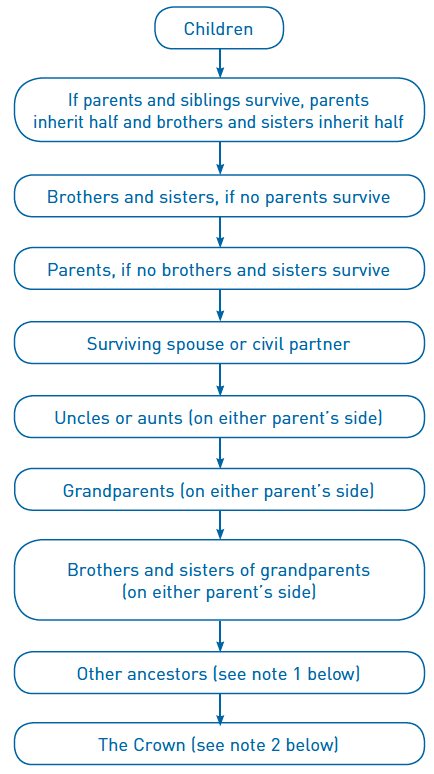What to do after a death in Scotland - practical advice for times of bereavement: revised 11th edition 2016 (web only)
General information on what to do after someone dies in Scotland and about succession and inheritance law. See https://www.mygov.scot/bereavement-benefits/ for the latest information about benefits.
21. The remainder of the estate
After the prior and legal rights have been satisfied, the rest of the intestate estate "devolves" according to legal rules. The chart on the next page describes the groups of people who inherit from an estate in this way.
If anyone is left alive in one group, no group further down the chart will inherit from the estate. For instance, if someone dies leaving children and one sister, the children only will inherit the remainder of the intestate estate. The order of succession in the chart is subject to the three general principles at section 22.

Note 1 Ancestors of the intestate person more remote than grandparents (for example, great-grandparents) successively take the whole. This applies to both maternal and paternal ancestors. However, if no ancestors survive in any generation, their brothers and sisters will inherit before ancestors of the next more remote generation.
This means, for example, that the brothers and sisters of a great-grandparent will inherit before the great-great-grandparents. If there are no surviving brothers and sisters of the intestate person's great‑grandparents who are also dead, the great‑great‑grandparents will inherit.
Note 2
If the executor cannot trace any of the dead person's relatives in the categories above, the estate may pass to the Crown as "ultimus haeres". The person who acts for the Crown in this capacity in Scotland is the Queen's and Lord Treasurer's Remembrancer (QLTR). You can find more about the QLTR's role at www.qltr.gov.uk. You will also find the QLTR's details in Part VI.
Contact
There is a problem
Thanks for your feedback